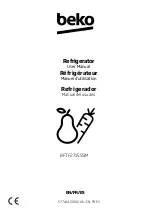
It is very important to set the correct
temperature for storing food in the
appliance. Micro organisms will cause
food which is not stored at the correct
temperature to deteriorate rapidly.
Temperature influences the growth rate
of these micro organisms. Reducing the
temperature reduces their growth rate.
The temperature in the appliance will
rise:
– the more often the door is opened
and the longer it is kept open,
– if too much food is stored in it at
once,
– the warmer the food is which is being
put into it,
– the higher the ambient temperature
surrounding the appliance.
The appliance is designed for use in
specific ambient temperatures
(climate ranges). Do not use in
ambient temperatures for which it is
not designed.
. . . in the refrigerator
We recommend a temperature of
5 °C
in the middle of the refrigerator section.
Temperature selection
The temperature is set with the temper-
ature dial.
^
Using a coin turn the temperature
dial in a clockwise direction to the
required setting.
Turn it only as far as it will go, then
turn it back again. Turning it beyond
its range would damage it.
The higher the setting, the lower the
temperature in the appliance.
With normal use a setting of between
2
and 3
is usually sufficient.
Temperature display
During normal operation the tempera-
ture display on the control panel shows
the temperature in the warmest part of
the appliance.
If the temperature in the appliance is
not within the range which can be
displayed, i.e. between 2 and 9 °C, only
a bar will show in the temperature
display.
Natural air circulation inside the
appliance will mean that there are areas
inside the appliance which will be
warmer or colder than the temperature
displayed. As long as dynamic cooling
has not been engaged this is quite
normal.
Make use of the different temperature
zones for storing your food correctly.
The correct temperature
10











































